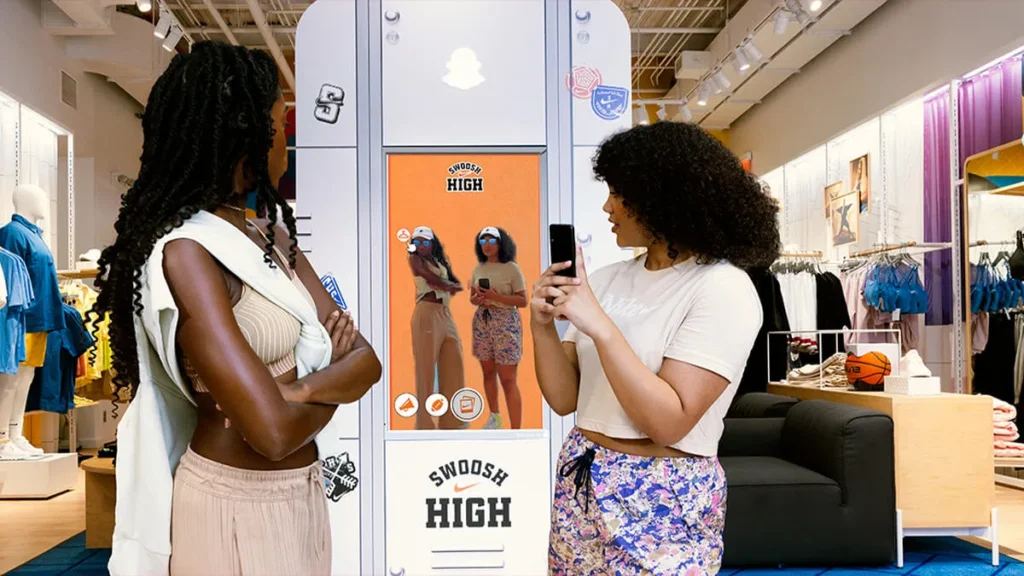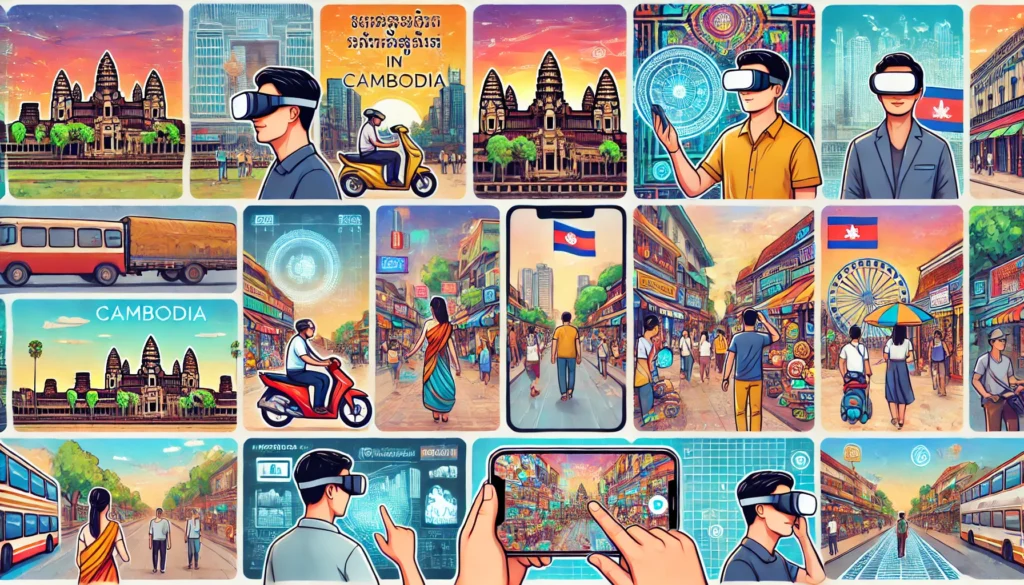The retail industry is in a constant state of evolution, driven by technological advancements and shifting consumer expectations. Among the latest and most impactful innovations is Augmented Reality (AR). AR has moved beyond a buzzword, becoming a powerful tool that allows retailers to create immersive shopping experiences, driving engagement, conversion, and customer loyalty. Let’s explore how AR is transforming the retail landscape and why it’s a game-changer for the industry.
1. AR Try-Ons: Enhancing In-Store and Online Shopping
AR try-ons have revolutionized how customers interact with products, whether they’re shopping in-store or online. This technology allows customers to virtually try on clothing, accessories, makeup, and more, providing a realistic preview of how products will look without the need to physically wear or handle them.
AR Mirrors in Physical Stores: Retailers are increasingly adopting AR mirrors, which overlay digital images onto a customer’s reflection, enabling them to try on outfits, cosmetics, or accessories virtually. This not only enhances the shopping experience by offering quick, contactless trials but also helps retailers reduce the need for extensive physical inventory.
Virtual Try-Ons for Online Shoppers: AR technology also bridges the gap for online shopping by allowing customers to visualize products on themselves in real-time through their smartphones or computers. This feature is particularly beneficial for fashion, cosmetics, and eyewear retailers, where the look and fit are critical factors in the purchasing decision.
Why It Matters: Whether through in-store AR mirrors or online virtual try-ons, AR technology increases customer confidence in their purchases. Products enhanced with AR experiences often see a 40% higher conversion rate compared to traditional listings. This boost in confidence leads to higher sales and reduced return rates, making AR a valuable tool for both online and brick-and-mortar retailers.
2. Interactive Product Demonstrations
AR can bring static products to life through interactive demonstrations. For instance, a customer interested in electronics could use AR to see how a device functions, view it in 3D, and even disassemble it virtually to explore its components. This level of interaction provides a deeper understanding of the product, which is often the final push needed to make a purchase decision.
Example: Major home appliance brands are using AR to allow customers to virtually explore the inside of their products. From examining the compartments of a refrigerator to understanding the workings of a washing machine, AR offers a level of detail that is both informative and engaging.
3. Gamification and Contests on Social Media
Gamification is another way AR is making retail more engaging. Brands can create AR-based games or contests that customers can participate in, either in-store or online. These campaigns not only generate excitement but also foster brand loyalty by rewarding customers for their engagement.
Successful Campaigns: Retails like Ocean Super Center have effectively used AR games to create user-generated content and boost brand engagement. The integration of AR in contests resulted in significant interaction, with thousands of users participating and sharing their experiences.
4. Personalization and Customization with AR Mirrors
AR mirrors are not just about trying on products—they also enable a high level of personalization and customization, which is increasingly important in today’s retail environment. By leveraging customer data, AR mirrors can offer personalized shopping experiences tailored to individual preferences and needs.
How It Works: When a customer stands in front of an AR mirror, the system can access their shopping history, preferences, and even biometric data (with their consent) to suggest products that suit their style, size, and preferences. For instance, the mirror might recommend clothing that complements the customer’s previous purchases or suggest makeup shades that match their skin tone.
Enhanced Shopping Experience: This personalized approach not only makes shopping more efficient but also creates a more enjoyable and engaging experience. Customers feel understood and valued, which can lead to increased brand loyalty and higher sales. Retailers can also use these insights to tailor marketing efforts and improve customer retention.
5. Gamify the In-Store Promotions to Increase Dwell Time and Sales
Retailers can use AR to gamify the in-store experience, encouraging customers to spend more time in the store and engage with the brand in new ways. AR scavenger hunts, for example, can lead customers around the store to unlock hidden content or rewards. This not only increases dwell time but also makes the shopping experience more interactive and enjoyable. Create an AR scavenger hunt that encourages customers to visit multiple locations within a store or across several stores. Shoppers can use their smartphones to unlock AR content, find virtual items, or collect rewards that lead to discounts or special offers. This gamifies the shopping experience, making it more interactive and fun.
Example: A mall could implement a holiday-themed AR scavenger hunt where customers must find virtual snowflakes hidden in various stores. Each snowflake could unlock a discount or a chance to win a prize, encouraging shoppers to explore the entire mall.
Turn every visit into an adventure with the AR Mirror Game by Mekongverse. Shoppers can play fun, gesture-based games to win instant discounts — either before purchasing to get a deal, or after spending a set amount to unlock bonus rewards. It’s a powerful way to boost engagement, increase sales, and turn buying into an interactive experience. No extra hardware needed.
6. AR Mirror Storefronts: Turning Window Shopping into an Experience
AR mirror storefronts are an innovative way to engage passersby and encourage them to enter your store. These interactive displays allow potential customers to virtually try on products right from the sidewalk, offering a taste of what’s inside.
How It Works: AR mirror storefronts use advanced technology to create an interactive display on your store’s windows. Passersby can use the AR mirrors to try on clothing, accessories, or makeup virtually, all without stepping inside. The display can also show dynamic product information, promotions, or even personalized recommendations based on visual recognition.
Driving Foot Traffic: These mirrors not only attract attention but also entice people to enter the store to complete their shopping experience. By offering a seamless transition from virtual try-on to in-store purchase, AR mirror storefronts can significantly boost foot traffic and conversions.
Example: A fashion retailer might use AR mirror storefronts to allow customers to try on the latest collection. The mirror could also offer exclusive in-store discounts, further encouraging passersby to come inside.
7. AR Photobooth Contest for Omnichannel Engagement
Boost foot traffic and brand buzz with the AR Photobooth Contest by Mekongverse. Invite shoppers to snap fun, branded photos in-store and join an online contest by sharing them on Instagram with your hashtag. Combine real-world excitement with digital reach — driving both in-store visits and social media engagement. It’s a smart way to connect online and offline, grow visibility, and boost sales. No extra hardware needed.
Example: Delight visitors and fill your space with energy using the AR Photo Booth by Mekongverse. Just like the “Oh Snap!” campaign at Paya Lebar Quarter, this interactive setup invites shoppers to snap photos with fun, themed AR filters, then share them online via QR code links. It drives real footfall, sparks long queues, and turns every guest into a brand ambassador with viral, hashtag-powered content.
8. Drive Foot Traffic to Stores with Coupons promotions
AR can be a powerful tool to drive foot traffic to physical storefronts by creating unique, in-store experiences that customers can’t get online. Here are some strategies:
Limited-Time Coupons: Distribute limited-time coupons that can only be redeemed in-store. These coupons could be shared via social media, email, or as part of a broader marketing campaign. The AR experience might include unlocking the coupon by completing a simple AR game or activity, adding an extra layer of engagement.
Example: A bookstore might offer an AR puzzle that customers must complete to unlock a coupon for a free book. The catch? The coupon can only be redeemed by visiting the store within a certain timeframe.
Conclusion
Augmented Reality is no longer just a buzzword—it’s a transformative force that is reshaping the retail industry. From enhancing in-store and online shopping experiences to personalizing customer interactions, gamifying the shopping journey, and driving foot traffic, AR offers retailers unparalleled opportunities to connect with their customers. As AR technology continues to advance, its impact on the retail landscape will only grow, driving sales and creating unforgettable shopping experiences.
For retailers looking to stay ahead of the curve, embracing AR is not just an option—it’s a necessity. Whether the goal is to enhance customer engagement, improve conversion rates, or simply offer something new and exciting, AR is the key to unlocking the future of retail.



